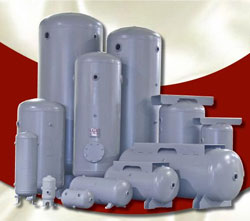Posted by Compressed Air Systems on | Comments Off on How to Size a Compressed Air Tank
Compressed air tanks, often referred to as air receiver tanks, are a vital part of all compressed air systems. They help balance the supply of air from the compressor with the demand from the system by acting as a reservoir during peak times. Additionally, they can remove water from the compressed air system and minimize system pulsations.
Achieving the maximum benefits from an air receiver tank necessitates choosing one that is properly sized for the compressed air system. In most cases, a receiver tank is sized at 2 gal/scfm. However, if big surges in demand are expected, the size is increased to between 4 and 10 gal/scfm. The following article goes into further detail about what an air receiver tank is, why it is important, and how to properly size one for a compressed air system.
What Are Air Receiver Tanks?
Air receiver tanks are engineered to temporarily store compressed air before it enters equipment or a piping system. They help connected compressed air systems operate efficiently during operations by acting as a buffer between the compressor and fluctuating buffer. Additionally, they can be used to supply additional air to the system to accommodate surges in demand and/or run the system even when the compressor is not running.
Compressed air systems use two types of air receiver tanks: primary and secondary. Primary tanks are located close to the air compressor system and act as air storage devices. Secondary tanks are located further from the compressor system while still being accessible to any device that requires air.
Why Are Receiver Tanks Important in Compressed Air Systems?
While it is technically possible for a compressed air system to function without a receiver tank, there are several reasons why they are a vital component of highly effective systems. First, they serve as reservoirs that supplement compressed air supply during peak demand. Second, they remove water that might be present in a compressor system by cooling the air. Third, they decrease the amount of pulsations experienced by the system.
Some of the key factors to consider when choosing a receiver tank for a compressed air system are:
- Size: An air receiver tank should be sized between 6–10 times the flow rate of the system. For example, compressors with a rating of 25 scfm at 100 psi should have a tank that is size at a minimum of 150 cubic feet.
- Working Pressure: Air receiver tanks must be fitted with a pressure relief valve and pressure gauge. The former should be set to 10% above the working pressure of the compressed air system.
- Drainage/Drying elements: A drain enables the receiver tank to expel water from the system. It can be manual or automatic. The inclusion of an air dryer and coalescing filter can further help improve the dryness of the compressed air.
How to Properly Size an Air Receiver Tank
 Air receiver tanks are sized in terms of volume (measured in gallons). They are available in sizes ranging from 5-gallon capacities to several thousand gallon capacities. It is important to choose the size based on the needs of the application. Key considerations to keep in mind include:
Air receiver tanks are sized in terms of volume (measured in gallons). They are available in sizes ranging from 5-gallon capacities to several thousand gallon capacities. It is important to choose the size based on the needs of the application. Key considerations to keep in mind include:
- Capacity: How much air can the air receiver store? It should be greater than the amount of air required for the application.
- Pressure: What compressor discharge pressure is required? What end-use pressure is required? The greater the difference between the two values, the smaller the receiver needed.
- Time: How much time (in minutes) does the tank take to supply the amount of air required without a significant drop in pressure?
- Air requirement: How much air does the end-user require to operate at optimal capacity?
In addition to these factors, sizing a receiver tank can vary depending on the compressor design.
Sizing a Compressed Air Tank for Reciprocating Air Compressors
Reciprocating air compressors rely on a receiver tank to store compressed air and eliminate pulsation before it is used for operations. When the tank is filled with enough compressed air, the connected device can be operated. Using the device drains the tank, so users will need to wait for it to fill back up if it is emptied before the device can be used again. Correctly sizing the air receiver tank to the compressor helps minimize interruptions by eliminating the risk of it emptying before the task is done.
Sizing an Compressed Air Tank for Stationary Air Compressors
Custom stationary air compressors utilize air receiver tanks that are more complex to size correctly. As a result, sizing should generally be performed by a qualified engineer. Factors influencing tank sizing include volume and pressure variations in demand, air compressor size, pipe/hose size and length, and control system.
Contact Us for Tank Sizing Help Today
Need help determining the right air receiver tank size for your system? Ask the experts at Compressed Air Systems! We offer high-quality air receiver tanks for various compressed air system needs. Our engineers can help you evaluate your system requirements and restrictions to identify the best tank solution.

